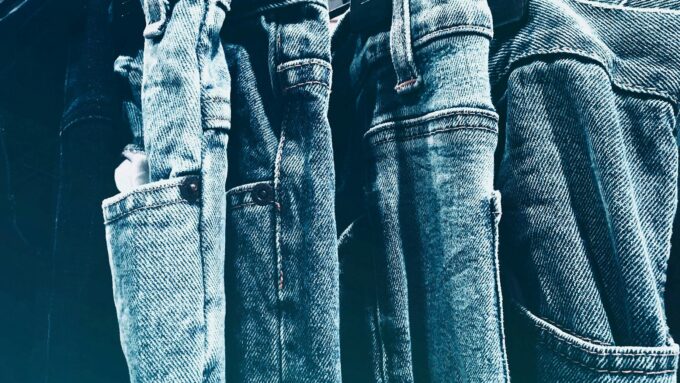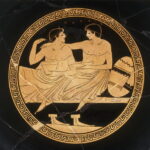
When a Pair of Jeans Became a Political Crisis
Last month, Sydney Sweeney smiled in a pair of jeans for American Eagle, and America had a nervous breakdown.
I didn’t think much of the ad when I first saw it in the mall—until my social media feeds turned into a war zone over denim. The advertisement was painfully ordinary: a blonde actress in jeans with the tagline “great jeans”—a harmless pun on “genes.” Within hours, social media erupted in accusations of Nazi propaganda. Critics declared that featuring “a blonde haired, blue-eyed white woman talking about her good genes” constituted fascist messaging.¹ The backlash was swift, intense, and revealing in ways its participants never intended.
But the real story isn’t the hysteria itself—it’s what the hysteria revealed about our collective enslavement to beauty, ideology, and the performance of identity. Both the defenders and critics of the ad were trapped in the same cage, worshipping at different altars of the same superficial temple.
The Tyranny of the Beautiful
How we reduce people to symbols and women to aesthetic objects
The most telling aspect of the Sydney Sweeney controversy wasn’t the accusations of fascism—it was how both sides reduced a human being to a collection of physical attributes and symbolic meanings.
Critics saw “blonde hair, blue eyes” and screamed Nazi. Defenders saw conventional beauty and cheered traditional femininity. Neither side saw Sydney Sweeney as a complete person.
This is the fundamental damage that our beauty-obsessed culture inflicts: it transforms people into symbols, women into ideological vessels, and human complexity into marketing categories. The traditional family structure that conservatives celebrate and progressives critique both depend on this same reductionism—the idea that a woman’s primary value lies in how she looks and what she represents rather than who she is.
The American Eagle ad perfectly encapsulated this trap. It promised that wearing the right jeans would make you the right kind of woman—confident, carefree, enviably beautiful. The critics, in attacking this message, reinforced its power by suggesting that visual representation carries such weight that it can constitute propaganda.
Both positions accept the premise that appearance equals identity, that how we look determines who we are.
This isn’t empowerment. It’s slavery wearing makeup. We’ve created a culture where women must constantly perform their acceptability—whether to beauty standards, political standards, or moral standards—rather than simply existing as full human beings.
The Prison of Aesthetic Politics
Understanding the psychology of beauty backlash
The psychology driving the backlash reveals how deeply we’ve internalized these beauty hierarchies. Critics saw Sydney Sweeney’s conventional attractiveness and experienced it as a threat—not because she represents fascism, but because she represents a standard of beauty that makes others feel inadequate by comparison.
Fear dominates this response, but not fear of political messaging. Fear of aesthetic inadequacy, of being found wanting by impossible standards, of losing relevance in a culture that prizes visual perfection above all else. The critics attacking the ad were essentially saying: “Your beauty makes us feel bad about ourselves, so we’ll destroy it by calling it evil.”
Envy operates at the deepest level—envy not just of Sydney Sweeney’s appearance, but of her effortless inhabiting of cultural ideals that others struggle to achieve or reject. Critics understand intuitively that aesthetic power translates to social power, economic opportunity, and cultural influence.² Rather than questioning why we’ve organized society around such superficial metrics, they attack those who benefit from them.
Projection reveals itself in the rush to label conventional beauty as supremacist. This reflects a psychological backlash to white aesthetic dominance—not because whiteness is inherently superior, but because Western media has long centered white beauty as the cultural default. When critics see Nazi propaganda in a blonde woman advertising jeans, they reveal more about their internalized relationship to these beauty hierarchies than any hidden ideology in the advertisement.
As Plato observed, beauty can inspire us toward truth—but only if we see through the physical to something deeper. Our culture has inverted this wisdom, making the physical appearance the ultimate truth and trapping everyone in its tyranny.
The Historical Arc of Aesthetic Politics
How we got here: from policy debates to image wars
Over the past decade, aesthetic representation has increasingly replaced material politics in public discourse. Where we once debated policy, we now debate imagery. Instagram culture, identity activism, and advertising merged into a single ecosystem of symbolic power—where who gets pictured matters more than what actually changes.
This shift reflects deeper cultural transformations: the rise of social media as a primary site of political engagement, the democratization of criticism through platforms like TikTok and Twitter, and the increasing importance of visual culture in how we understand identity and belonging.
The Sydney Sweeney controversy represents the logical endpoint of these trends—where a clothing advertisement becomes a flashpoint for debates about representation, power, and cultural values.
We’ve created a world where aesthetics is politics, and politics is performance.
The Cage of Traditional Values
How conservative and progressive responses trap women in different prisons
The defenders of the ad fell into their own trap. Many celebrated Sydney Sweeney as representing “traditional American beauty” or “wholesome femininity”—reducing her to a symbol of conservative values just as surely as critics reduced her to a symbol of oppression.
Traditional values confine women through domestic roles and aesthetic expectations; modern culture confines them through digital performance and political correctness.
Different systems, same prison.
Both progressives and conservatives remain enslaved to these categories—progressives want to expand or invert them, conservatives want to preserve them. Neither questions whether organizing human worth around appearance and symbolic representation is fundamentally dehumanizing.
Living in Beauty’s Cave
Plato’s allegory of the cave takes on new meaning in this context. We’re all chained in darkness, mistaking shadows of beauty for reality itself. The shadows we see aren’t just political—they’re aesthetic, commercial, and sexual.
In the cave of beauty culture, we mistake physical appearance for personal worth, visual representation for social progress, and aesthetic pleasure for meaningful connection. Critics of the Sydney Sweeney ad thought they were fighting fascism, but they were actually fighting their own reflection—their own entrapment in a system that makes appearance supremely important.
The cave-dwellers attack anyone who reminds them that they’re looking at shadows. Sydney Sweeney’s beauty becomes threatening because it forces confrontation with the gap between ideal and reality, between what we are and what we think we should be. Rather than questioning why we’ve made beauty so central to human value, we attack either the beautiful or those who appreciate beauty.
This is why the Platonic concept of Beauty as a Form—a transcendent reality beyond physical appearance—is so radical. It suggests that true beauty points beyond itself to something higher: truth, goodness, the full realization of human potential. But we’ve inverted this wisdom, making physical beauty the endpoint rather than the beginning of understanding.
The Prison of Performance
How we’ve reduced women to visual objects
The real damage isn’t political—it’s existential. We’ve created a culture where women exist primarily as visual objects to be consumed, criticized, or celebrated, but rarely as complete human beings with inner lives independent of their appearance.
The American Eagle ad perpetuates this by selling the fantasy that the right clothes will make you the right kind of woman. The critics perpetuate it by suggesting that visual representation constitutes a form of violence.
Both positions accept that women’s appearance carries such cultural weight that it becomes inherently political.
This is what feminist theorist bell hooks called the “politics of recognition”—the way marginalized groups fight for better representation rather than questioning why representation has become so important.⁶ We argue about which women should be featured in ads rather than asking why we’re looking to advertisements for validation in the first place.
We worry about whether the model represents the “right” demographics but ignore whether the underlying message promotes human flourishing.
The traditional family structure often reinforced this dynamic by organizing women’s lives around their roles as wives and mothers—identities defined in relation to others rather than as autonomous individuals. The nuclear family, whatever its benefits, frequently functioned as a system for containing and channeling female potential into narrow acceptable forms.
Modern beauty culture has simply updated this containment system. Instead of being confined to domestic roles, women are now confined to performing their acceptability across multiple platforms and standards simultaneously—professional, sexual, political, maternal, aesthetic.
The Economics of Enslavement
The deeper issue is how both marketing and activism have turned human insecurity into profit. The beauty industry generates hundreds of billions annually by making people feel inadequate, then selling them solutions. The outrage industry generates attention and influence by making people feel threatened, then offering them belonging.
This visual system, though now policed by women and activists alike, was originally built by industries that profit from making female beauty a competitive marketplace—often for male approval or market valuation. Both systems depend on keeping people focused on surface-level concerns rather than deeper questions about human flourishing. As long as we’re arguing about whether Sydney Sweeney represents fascism or femininity, we’re not asking why we’ve organized society around impossible beauty standards that make most people miserable.
Studies consistently show that exposure to idealized images increases body dissatisfaction, anxiety, and depression regardless of the images’ political content (Grabe, Ward, & Hyde, Psychological Bulletin, 2008). The damage comes from the comparison itself, not from any specific ideology being promoted. Traditional “wholesome” imagery can be just as psychologically harmful as overtly sexualized content because both create unrealistic standards.
The American Eagle controversy revealed how completely we’ve internalized these standards. Even the critics couldn’t escape the logic of aesthetic evaluation—they just applied different criteria. Instead of questioning why appearance matters so much, they argued about which appearances should be permitted.
The Deeper Prison
The most insidious aspect of beauty culture is how it makes its victims complicit in their own oppression. Women learn to police themselves and each other, constantly monitoring appearance, behavior, and symbolic meaning. The Sydney Sweeney backlash was largely driven by women attacking another woman for being too conventionally attractive—a perfect example of this internalized oppression.
Traditional family structures often functioned similarly, with women enforcing gender norms on each other and their daughters. The expectation that women should be beautiful, pleasant, and symbolically pure was maintained not primarily through male coercion but through female participation in the system.
This creates what sociologists call “false consciousness”—people defending systems that harm them because they’ve been taught to see their oppression as natural or beneficial. Women compete for male attention by conforming to beauty standards rather than questioning why male attention should be the prize. Critics attack beautiful women rather than questioning why beauty has become so important.
Both responses keep everyone trapped in the same cage, fighting over positions within a hierarchy rather than questioning the hierarchy itself.
The Path Beyond
Imagining freedom from aesthetic tyranny
The solution isn’t better representation or different beauty standards—it’s questioning why we’ve made appearance so central to human value in the first place. Real liberation would mean being able to appreciate Sydney Sweeney’s beauty without making it politically significant, and being able to critique beauty culture without attacking beautiful people.
This requires recognizing that the problem isn’t individual women like Sydney Sweeney, or even individual advertisements like American Eagle’s campaign. The problem is a cultural system that reduces human worth to visual symbols and makes people’s appearance more important than their inner lives.
True feminism would free women from having to perform their acceptability constantly—whether to beauty standards, political correctness, or traditional family roles. It would allow women to exist as complete human beings rather than as symbols in other people’s ideological battles.
Maybe we’re just too afraid to ask the questions that matter. But we should. We really should.
Traditional family values, at their best, recognized that human worth transcends appearance and achievement. But they often became distorted into systems for controlling women’s bodies and choices. Similarly, progressive values, at their best, recognize human dignity and complexity. But they often become distorted into new forms of performance and policing.
Breaking the Chains
What it would take to live beyond beauty politics
The American Eagle controversy revealed our collective enslavement to superficial categories and symbolic thinking. Until we can see a blonde woman in jeans without immediately calculating her political meaning, we remain prisoners of our own projections.
Real freedom would mean being able to appreciate beauty without being threatened by it, to critique cultural standards without attacking individuals, and to value human beings for their full complexity rather than their symbolic utility.
The question isn’t whether Sydney Sweeney represents fascism or femininity—it’s why we need her to represent anything at all. The question isn’t which beauty standards are politically correct—it’s why we’ve made beauty standards so important that they generate political controversy.
Until we can answer these questions honestly, we’ll remain trapped in the cave, fighting over shadows while the real world passes us by. The chains that bind us aren’t imposed by others—they’re forged from our own insecurities, maintained by our own participation, and locked by our own refusal to imagine something better.
The real propaganda isn’t in the advertisement—it’s in our assumption that appearance equals identity, that visual representation carries moral weight, and that human worth can be measured in aesthetic terms.
Breaking free requires recognizing these assumptions as the prisons they are, and choosing to value human beings for who they are rather than what they look like or represent.
What would it take to live in a culture where beauty wasn’t currency? And are we brave enough to build it?
References:
- The Guardian, “Born in the USA: Is American Eagle really using whiteness to sell jeans?” July 31, 2025
- Paglia, Camille. “Sexual Personae: Art and Decadence from Nefertiti to Emily Dickinson” (1990)
- Plato, “Republic,” Book VII (The Allegory of the Cave)
- Plato, “Phaedrus,” 249d-250e (Beauty as a Form)
- NBC News, “American Eagle sparks backlash for touting Sydney Sweeney’s ‘great jeans'” July 28, 2025
- hooks, bell. “Killing Rage: Ending Racism” (1995)
- Wolf, Naomi. “The Beauty Myth: How Images of Beauty Are Used Against Women” (1990)
- Orwell, George. “Politics and the English Language” (1946)
- Marx, Karl & Engels, Friedrich. “The German Ideology” (1845) – concept of false consciousness


